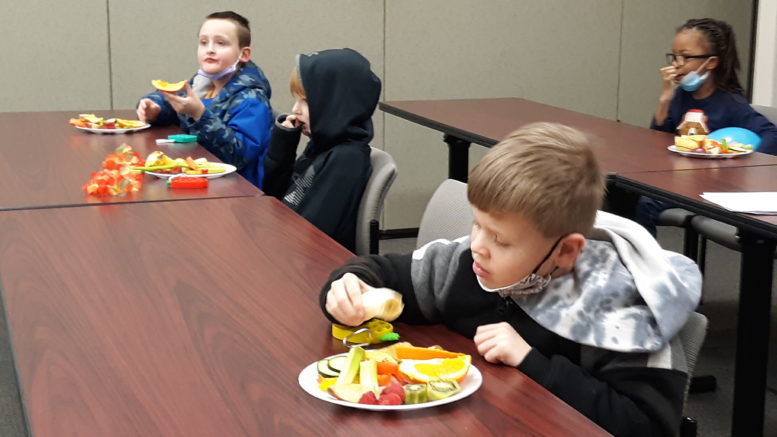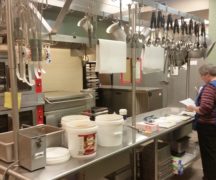By JAN LARSON McLAUGHLIN
BG Independent News
Feeding families can take a huge bite out of any household budget. But some key tips can help trim the fat from food purchases.
Don’t do your grocery shopping at a convenience store. Don’t buy “baby” carrots, when you can buy whole carrots for less. And make a list – then stick to it as you navigate the grocery store aisles.
Local parents were given tips last month on how to fuel their families without breaking their food budgets. The “Dinner on a Dime” program was put on for parents whose children are part of the Community Learning Centers, hosted by the Wood County Educational Service Center.
The food tips were presented by Lisa Schlumbohm, from the SNAP-Ed program through the OSU Extension Service in Wood County.
Schlumbohm explained the three basic steps to feeding a family while sticking to a budget – the pre-grocery store planning, the secrets to the shopping experience, and the post-grocery store tips.
In the room next door, the parents’ children were learning some lessons themselves. They were encouraged to give kiwi and cucumbers a chance. And they found out that celery may not be exciting on its own – but add a little peanut butter and it’s a hit.
For the parents, Schlumbohm stuck to the basics.
“We all have to live on a budget,” she said. But beyond the cost, factors like making meals fast, easy and appealing to kids, also matter, Schlumbohm acknowledged.
Food budgets compete with other monthly expenses like rent, mortgage, child care costs, gas, utilities, car payments and utility bills. Schlumbohm walked parents through the math of figuring out just how much their households can spend on food each month.
Food budgets, she said, are often stretched over grocery stores, convenience stores, fast food, take-out deliveries, vending machines and concession stands.
Schlumbohm suggested the following strategies to rein in food costs: Make meals at home and limit eating out. Cut out snacks at the movies, don’t go to the gas station to get doughnuts, and bring snacks to work rather than frequenting the vending machines.

Above all, plan ahead, she said.
Schlumbohm challenged the parents to put all their food receipts into an envelope – then review them at the end of the month. That way they will know exactly where their food dollars are being spent.
“Planning ahead is key to dinner on a dime,” she said.
Before heading out to the grocery store, Schlumbohm suggested the following planning steps:
- Shop your pantry first. “Use what you have – don’t let it go to waste.”
- Look through store ads or use store apps.
- Look for coupons.
- Make a menu, then make a list for everything you need.
“I want you to be buying things you need – not things you want,” she said. “Wants come last.”
Schlumbohm sticks to her own strict budget at the grocery store. She puts the “must have” items in the main part of the shopping cart, and the “want” items in the child seat or on the bottom rack of the cart.
If she is over budget when she’s done loading the cart, the “want” items are easily located to leave behind.
“If I go over, I abandon them,” she said. “If you find abandoned items in the dog food aisle, they’re probably mine.”
Schlumbohm offered a strategy for grocery shopping trips:
- “Stick to your game plan,” she said.
- Eat before you go.
- Avoid distractions from flashy gimmicks.
- Avoid impulse buys.
- Don’t be “dazzled.” Schlumbohm said her young son is swayed by images of LeBron James on Gatorade.
- Don’t pay for convenience. Avoid chopped fruits and vegetables. “Don’t pay for someone to do the work for you,” she said.
- Avoid frozen dinners. Instead, ask “how can I make it myself?”
- Get the gallon jugs of water, not the individual water bottles.
- The most expensive items are often at eye level – so look up and down for deals.
- Compare prices.
- Know the prices of typical items. “Don’t let a pretty balloon with ‘sale’ written on it influence you,” she said. “Be savvy.”
Schlumbohm also suggested families can save by making their own version of store-bought items. For example, a type of Manwich sloppy joe mix can be concocted at home with ketchup, barbecue sauce and brown sugar.
“I love talking about how you can save money at the grocery store,” she said.
Once you have the groceries at home, there is still more work to be done to squeeze the most out of your food budget, such as:
- Store items like potatoes, onions, winter squash and garlic in a dark dry cabinet. “They are going to last a lot longer,” she said.
- Clean and get fruit ready to eat. Putting washed grapes in a bowl in the refrigerator will make them convenient for the family. “It’s an easy, quick snack,” she said.
- Put items like strawberries at the front of the refrigerator since they don’t last long.
- Start a container of soup stock in the freezer, and add items like leftover vegetables, carrot peels and celery stalks rather than throw them out.
- Don’t overstock.
- Keep an eye on expiration dates.
- Move items that need to be eaten sooner to the front of the refrigerator.
- Use fruit that is getting soft in smoothies, or brown bananas in bread.
- “Freeze before it’s wasted,” she said. “You don’t want that food to go to waste.”
Schlumbohm also talked about how to include children in the meal planning, shopping and preparation phases. She suggested finding jobs that children can do in the kitchen.
Her 5-year-old son’s first job was operating the lettuce spinner. He is now in charge of setting the table, and makes dinner once a week, turning items like extra hotdog buns into homemade pizza. It saves the buns from being wasted, and gives him a chance to be part of the meal making process.
“Make it a fun culture around food,” Schlumbohm said.


